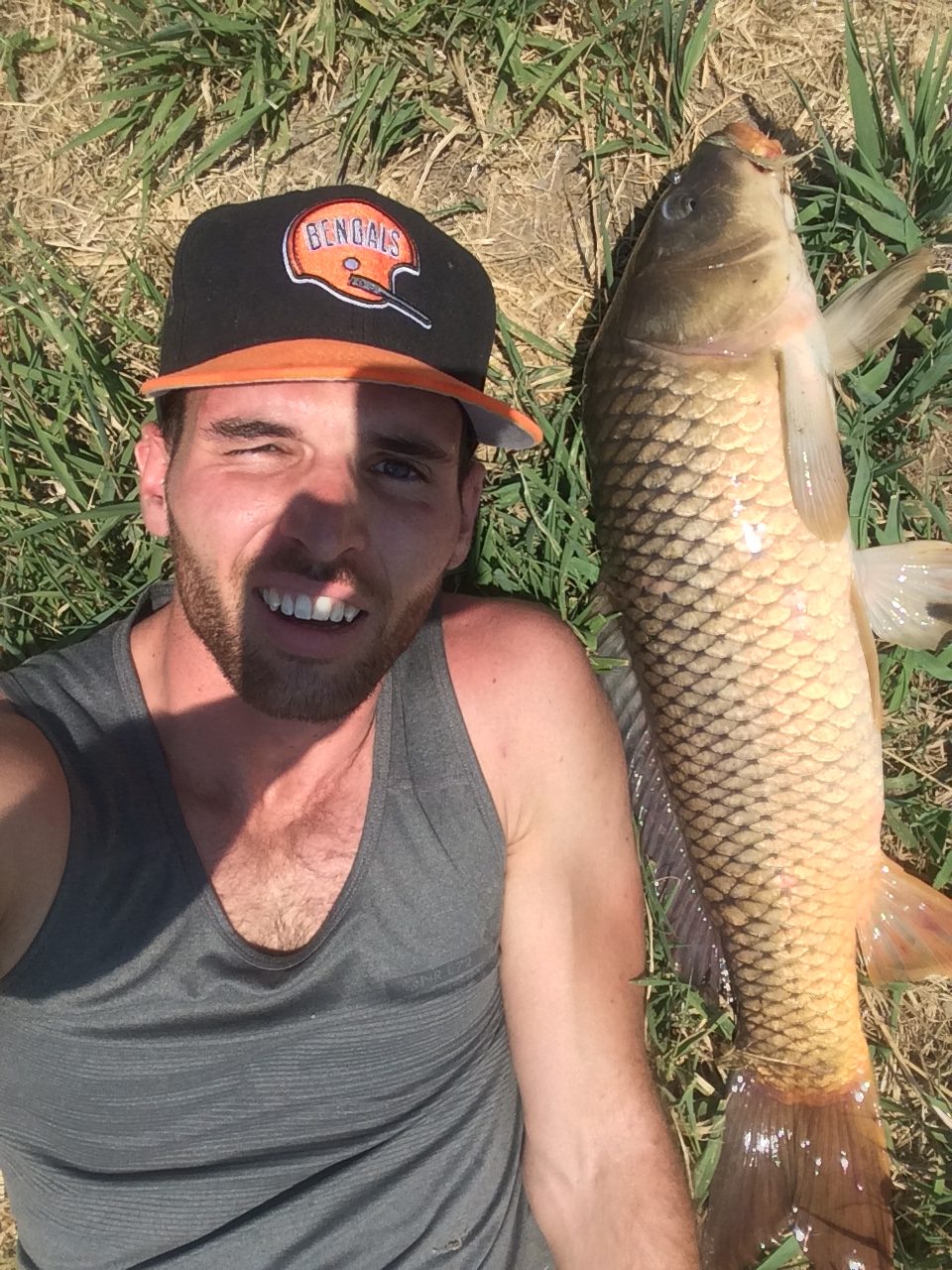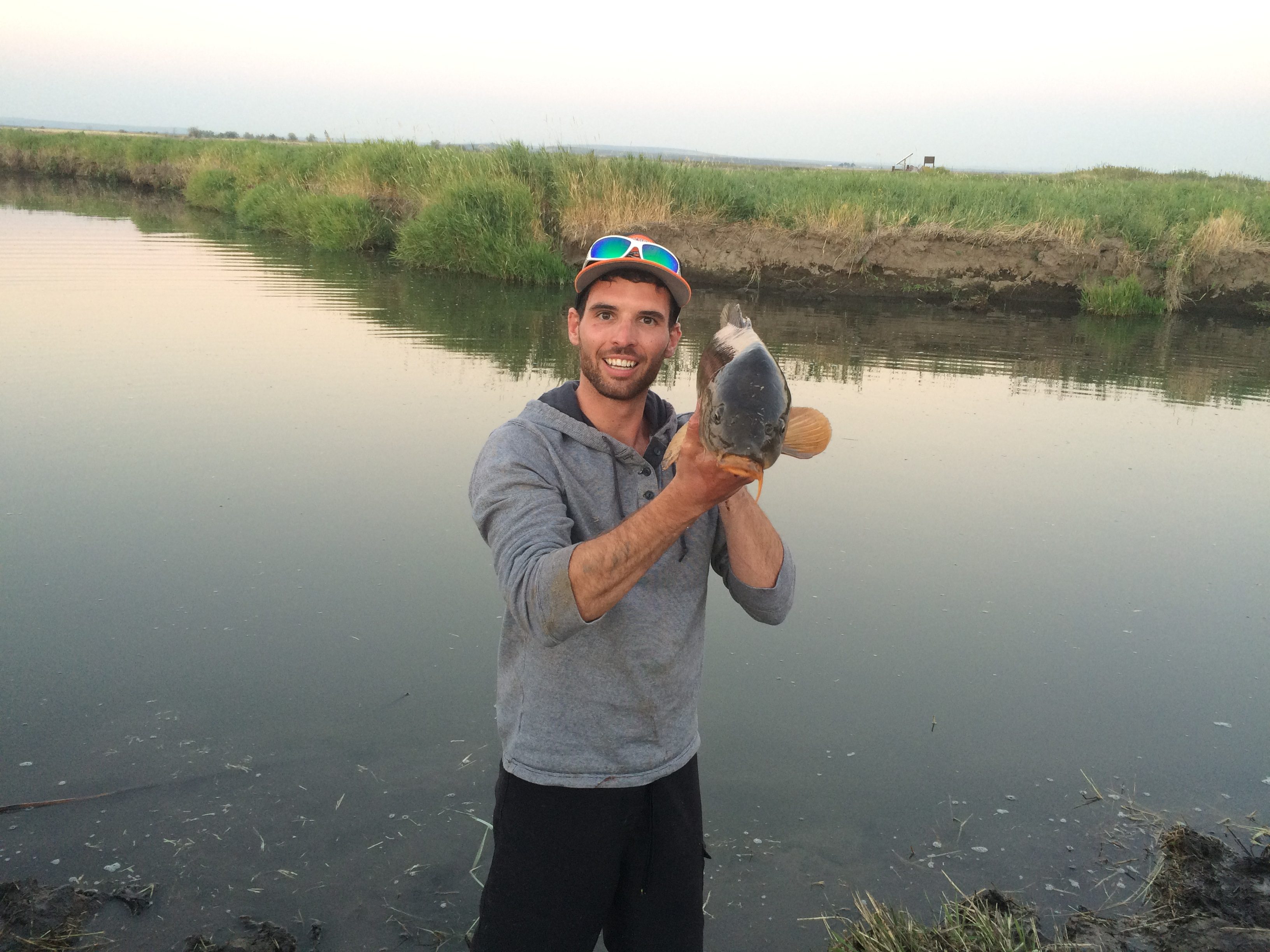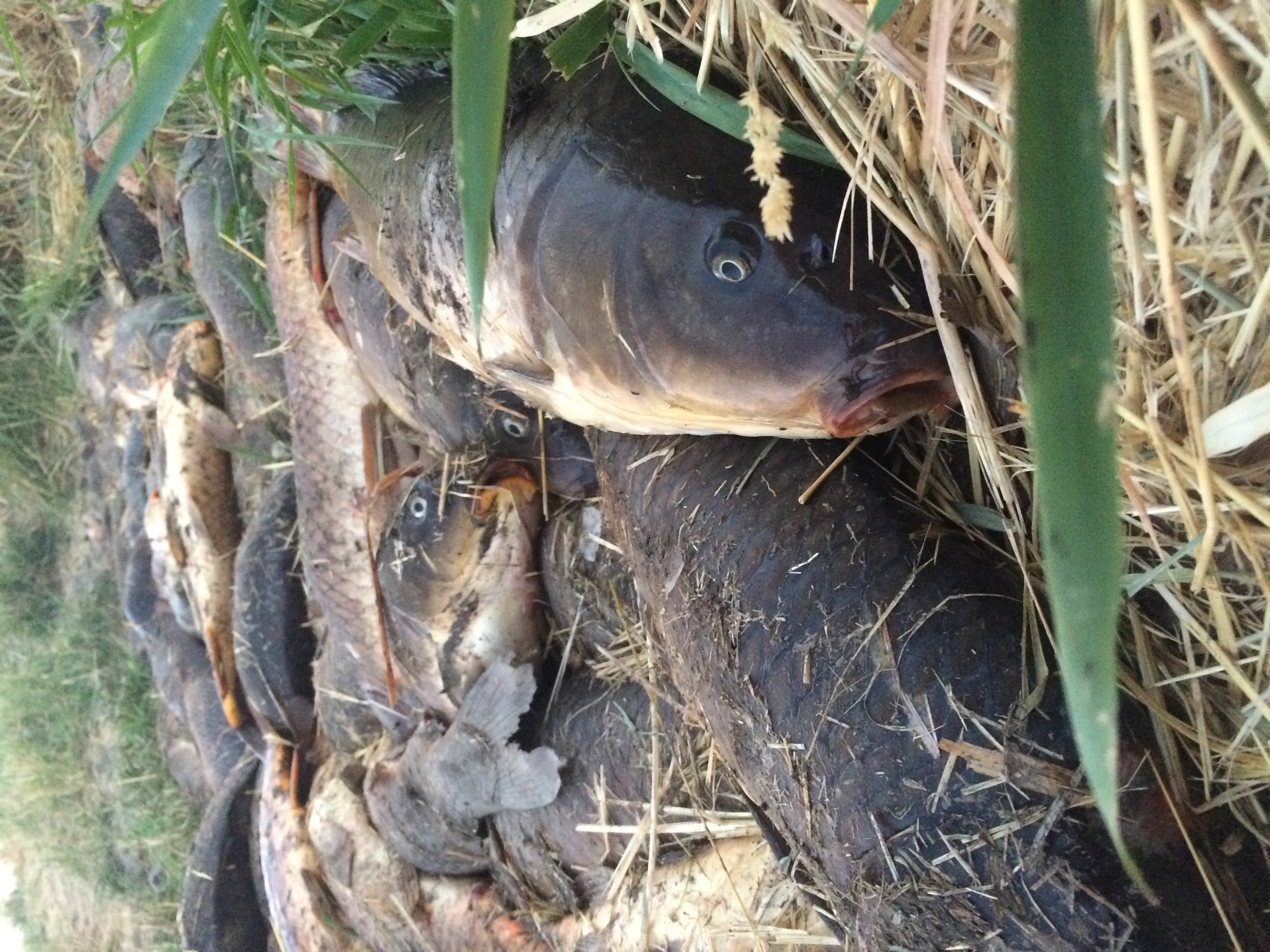
Species: Common Carp (Cyprinus carpio)
Location: Malheur River, Princeton, OR
Date: August 22, 2015
Imagine seeing a fish fish with some frequency for years when traveling but never having the appropriate gear to target it successfully. That’s the story of me fishing for Common Carp.
There are no carp populations in Klamath County where I live, which, in a county larger than Delaware, says something.
Nearby counties have carp populations, but having neither fished for carp nor known anyone who did for years, it meant carp was basically just a pipe dream.
That is, until my friend Ben Fry told me of this amazing fishery in the middle of the desert where he and his brother, Chuck, slayed carp the weekend before.
***
I’d just been offered a teaching job at Henley Middle School, and I accepted the position while sitting in my office at Klamath Community College, not having even applied. I was excited, but I was nowhere near ready.
When I told my boss at KCC, I agreed to stay and work the swing shift until they found a replacement. This made my schedule crazy, and I knew if I didn’t go fishing this weekend, I might not have another shot.
So I loaded up my car and headed into the desert.
***
When we arrived at Malheur National Wildlife Refuge, the short carp season (August 1 – September 15) was half over. I assumed this meant skittish, heavily pressured fish, but that wasn’t the case.
Within 10 minutes of throwing my corn in the water, I had my first carp on. Ben and his kids, Gabe and Rose, caught theirs shortly thereafter.

Once we figured out how to fish for them and accepted that in 90-to-100-degree heat and thick smoke, it was going to remain unpleasant, we hit our rhythm and started smashing fish left and right.
***

This season opens as a damage control measure to help curb the invasive carp population which has expanded exponentially since the 1950s introduction until it took over and wiped out native species. It’s now so bad that most aquatic vegetation is gone, and ducks don’t stop here anymore, despite its historic presence as a major Pacific Flyway stopover.
So we killed every carp we caught. For someone who does almost exclusively catch-and-release fishing, this was tough.
At first, the Refuge staff came and picked up them in trucks and carted them away for fertilizer, but then they gave up, leaving us sitting and fishing by a pile of dead carp in 90-plus-degree heat. It wasn’t great.
***
Fishing two rods at once, we were constantly fighting fish. The kids got tired, so we had to keep them entertained.

We continued to catch fish, and quickly realized they were stunted in the seven- to ten-pound range. Only one fish was under six pounds, and none topped 13. Still, an eight-pound carp is a better stunted fish than an eight-inch bass.
We continued fishing.

It didn’t let up, and neither did we. We scarfed down sandwiches and drinks, but eventually the kids had to call it quits. Ben and I remained in hopes of either a monster carp or a Mirror Carp — neither of which came.

Once the sun started going down, the bite slowed. It didn’t stop, but it slowed. We’d been at it for more than 12 straight hours, and we’d each probably lost two or three pounds of fluid in sweat. It was a long, hot day, and I finished with 44 carp. Ben had something like that many, too.

Read about this from a different, more punny angle here and then read more about what happened to all of the carp we killed here.
#SpeciesQuest // #CaughtOvgard
Read the next entry in #SpeciesQuest here: Species #71 — Slender Sculpin.


Thanks for a marvelous posting! I seriously enjoyed reading it, you might be a great author.
I will remember to bookmark your blog and may come back in the foreseeable future.
I want to encourage one to continue your great writing, have a nice afternoon!
I relish, result in I found exactly what I was looking for.
You’ve ended my 4 day lengthy hunt! God Bless you man. Have a great day.
Bye
Fascynujący artykuł, na pewno jeszcze będę odwiedzał tą stronę.
np04ni
Tights, an essential element of style since the 1950s, blend fashion with functionality.
Combining stockings with panties in a single garment,
they provide a seamless solution for smooth and sleek appearance.
Pantyhose conceal imperfections, promote better circulation, and provide gentle support for long days.
With options ranging from sheer to opaque, pantyhose offer endless possibilities for self-expression. Even in men’s fashion, pantyhose have practical uses, especially in performing arts.
Despite the trend towards casual attire, pantyhose remain cherished for their elegance and sophistication. In professional or formal settings, for special events, or simply out of personal choice,
women still choose to wear pantyhose, maintaining their status as a timeless accessory.
I don’t think the title of your article matches the content lol. Just kidding, mainly because I had some doubts after reading the article.
Hello! Fantastic article! Thanks for sharing such insightful
information. Can’t wait to read more. Cheers!
frz2jm
4f33b0
Detailing samochodu jest całościowy proces czyszczenia oraz odnawiania
pojazdu, mający na celu przywrócenie jego pierwotnego stanu
oraz także utrzymanie jego wartości. Tego
rodzaju specjalistyczna usługa nie skupia się tylko do podstawowego czyszczenia pojazdu,
ale skupia się na eliminowaniu wszystkich plam oraz uszkodzeń z jego
powierzchni, zarówno wewnątrz, jak i na zewnątrz.
Najważniejszym krokiem w detailingu samochodu jest precyzyjne oczyszczenie karoserii
z kurzu, owadzych pozostałości a także wszelkich innych zabrudzeń.
Stosuje się do tej czynności profesjonalne detergenty i narzędzia, które zapewniają dogłębne oraz bezpieczne dla powierzchni oczyszczanie.
Po tym etapie ten może obejmować usuwanie rys, odświeżanie lakieru a także ochronę go woskami lub ceramicznymi powłokami, które chronią trwałą ochronę przed wpływem czynników atmosferycznych.
Wnętrze także jest poddawane dokładnej pielęgnacji.
Eliminuje się wszelkie zabrudzenia z tapicerki, wykładzin podłogowych, deski rozdzielczej oraz
innych elementów wnętrza pojazdu. Dodatkowo, starannie czyszczą się
i odświeżają elementy wykonane ze skóry, a także przeprowadza się dezynfekowanie i odświeżenie całkowitego wnętrza, dla zapewnienia pełen komfort jazdy.
Detailing samochodu to nie tylko czyszczenie, ale także
seria czynności, który ma na celu
odtworzenie świeżości i estetyki pojazdu. Dzięki niemu samochód prezentuje się świeżo po
wyjeździe z salonu, zwiększając jego cenę podnosi się.
Ponadto, systematyczne czyszczenie może przyczynić się do zwiększenia trwałości lakieru oraz elementów wnętrza,
co ma wpływ na dłuższą żywotność pojazdu.
Specjalistyczne usługi detailingowe są dostępne przez profesjonalne, które posiadają niezbędnymi narzędziami i sprzętem, środkami chemicznymi, oraz ekspertyzą, dla zapewnienia wszechstronną i skuteczną pielęgnację pojazdu.
Dla wielu entuzjastów samochodów detailing samochodów stało się
nie wyłącznie koniecznością, ale również metodą wyrażenia indywidualności
oraz dbałość nad swój pojazd.
fj0m8c
2lkmq7
8vcmx4
04dh38
z1bj9w
I like this web blog so much, saved to favorites.
0un41p
ey8n94
Your terms Have a very strategy for sticking with me extensive after I’ve go through them.
Dear caughtovgard.com owner, Thanks for the post!
Wow, this website is absolutely amazing! It’s so captivating and certainly worth checking out.
I’m impressed by the informative content and user-friendly design. Continue the great work!
Hello caughtovgard.com webmaster, Thanks for the well-organized and comprehensive post!
9deqky
4cbrbn
It¦s actually a cool and useful piece of info. I am happy that you simply shared this useful information with us. Please stay us informed like this. Thank you for sharing.
Hi there, You have performed a great job. I will certainly digg it and individually suggest to my friends. I’m sure they’ll be benefited from this site.
naturally like your website however you have to test the spelling on several of your posts. Several of them are rife with spelling problems and I in finding it very bothersome to tell the truth nevertheless I will surely come back again.
Of course, what a great website and educative posts, I definitely will bookmark your blog.Have an awsome day!
Dear caughtovgard.com admin, You always provide clear explanations and step-by-step instructions.
Dear caughtovgard.com administrator, Thanks for the comprehensive post!
Would you be interested in exchanging hyperlinks?
Enjoyed looking through this, very good stuff, appreciate it. “Success doesn’t come to you…you go to it.” by Marva Collins.
Keep working ,splendid job!
What is Gluco Freedom? Millions of people suffer from blood sugar problems, despite the fact that many factors are beyond their control.
so much wonderful information on here, : D.
Heya i am for the primary time here. I found this board and I in finding It truly helpful & it helped me out much. I hope to offer one thing again and aid others such as you aided me.
Youre so cool! I dont suppose Ive learn something like this before. So good to find anyone with some original ideas on this subject. realy thank you for beginning this up. this website is one thing that is wanted on the web, someone with somewhat originality. helpful job for bringing one thing new to the internet!
I¦ve recently started a blog, the info you offer on this web site has helped me tremendously. Thanks for all of your time & work.
66glgt
ProvaDent: What Is It? ProvaDent is a natural tooth health supplement by Adam Naturals.
What is Zen Cortex? ZenCortex is not just another drop in the ocean of dietary supplements
Hello my loved one! I want to say that this article is amazing, great written and include approximately all vital infos. I would like to peer extra posts like this .
ri6cob
That is the fitting blog for anybody who desires to seek out out about this topic. You understand a lot its almost laborious to argue with you (not that I actually would want…HaHa). You undoubtedly put a new spin on a subject thats been written about for years. Nice stuff, just nice!
I have fun with, cause I found just what I was having a look for. You’ve ended my 4 day lengthy hunt! God Bless you man. Have a great day. Bye
I’m still learning from you, while I’m making my way to the top as well. I absolutely liked reading everything that is posted on your website.Keep the aarticles coming. I enjoyed it!
Your put up was a Pleasure to go through. You’ve got a actual talent for writing and it reveals with your get the job done.
whoah this blog is magnificent i love reading your posts. Keep up the great work! You know, many people are hunting around for this info, you could aid them greatly.
fantastic publish, very informative. I ponder why the opposite specialists of this sector don’t understand this. You must proceed your writing. I’m sure, you’ve a great readers’ base already!
whoah this blog is excellent i love reading your articles. Keep up the great work! You know, many people are looking around for this info, you can help them greatly.
This blog is definitely rather handy since I’m at the moment creating an internet floral website – although I am only starting out therefore it’s really fairly small, nothing like this site. Can link to a few of the posts here as they are quite. Thanks much. Zoey Olsen
This web site is really a walk-through for all of the info you wanted about this and didn’t know who to ask. Glimpse here, and you’ll definitely discover it.
I believe this web site has got some rattling fantastic information for everyone :D. “Anybody who watches three games of football in a row should be declared brain dead.” by Erma Bombeck.
Hi caughtovgard.com webmaster, Thanks for the well written post!
Dear caughtovgard.com webmaster, You always provide great examples and real-world applications.
I found this article both enjoyable and educational. The points made were compelling and well-articulated. Let’s dive deeper into this subject. Feel free to visit my profile for more interesting reads.
I do enjoy the way you have presented this situation and it does indeed provide me a lot of fodder for thought. On the other hand, because of what I have witnessed, I just simply wish as the feedback stack on that men and women continue to be on issue and not embark on a soap box involving the news of the day. All the same, thank you for this superb point and while I do not really agree with this in totality, I regard your perspective.
What Is ZenCortex? ZenCortex is a natural supplement that promotes healthy hearing and mental tranquility. It’s crafted from premium-quality natural ingredients, each selected for its ability to combat oxidative stress and enhance the function of your auditory system and overall well-being.
I like this website very much so much superb information.
I have been exploring for a little bit for any high quality articles or blog posts on this kind of area . Exploring in Yahoo I at last stumbled upon this web site. Reading this info So i am happy to convey that I’ve a very good uncanny feeling I discovered just what I needed. I most certainly will make sure to do not forget this web site and give it a glance on a constant basis.
I reckon something really special in this internet site.
I am pleased that I noticed this site, exactly the right info that I was searching for! .
You got a very wonderful website, Gladiola I discovered it through yahoo.
I think this is one of the most significant information for me. And i’m glad reading your article. But want to remark on some general things, The site style is wonderful, the articles is really great : D. Good job, cheers
I feel that is one of the most significant info for me. And i am happy studying your article. However should observation on some normal issues, The website taste is perfect, the articles is in point of fact excellent : D. Excellent task, cheers
Hello are using WordPress for your blog platform? I’m new to the blog world but I’m trying to get started and set up my own. Do you require any coding knowledge to make your own blog? Any help would be really appreciated!
Good – I should certainly pronounce, impressed with your web site. I had no trouble navigating through all the tabs as well as related information ended up being truly easy to do to access. I recently found what I hoped for before you know it in the least. Reasonably unusual. Is likely to appreciate it for those who add forums or anything, website theme . a tones way for your customer to communicate. Nice task..
Tonic Greens: An Overview Introducing Tonic Greens, an innovative immune support supplement meticulously crafted with potent antioxidants, essential minerals, and vital vitamins.
Real good information can be found on site. “I know of no great men except those who have rendered great service to the human race.” by Francois Marie Arouet Voltaire.
I’d always want to be update on new blog posts on this web site, bookmarked! .
Thanks for helping out, great info .
It?¦s really a great and helpful piece of info. I am glad that you simply shared this helpful information with us. Please stay us informed like this. Thank you for sharing.
Only wanna remark that you have a very nice site, I enjoy the layout it really stands out.
Usually I don’t read article on blogs, but I would like to say that this write-up very compelled me to take a look at and do so! Your writing style has been surprised me. Thank you, very nice post.
whoah this weblog is excellent i like studying your posts. Keep up the great work! You recognize, a lot of individuals are looking around for this info, you can aid them greatly.
I recognize how you broke down elaborate ideas into simple conditions. It designed it easier to know.
I’m still learning from you, while I’m trying to reach my goals. I certainly love reading all that is written on your site.Keep the stories coming. I liked it!
Enjoyed studying this, very good stuff, regards.
I view something truly special in this website.